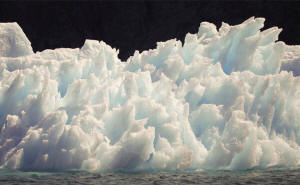|
Thaw could release Cold War-era U.S.
toxic waste buried under Greenland's ice
 Send a link to a friend
Send a link to a friend
 [August 06, 2016]
OSLO (Reuters) - Global warming
could release radioactive waste stored in an abandoned Cold War-era U.S.
military camp deep under Greenland's ice caps if a thaw continues to
spread in coming decades, scientists said on Friday. [August 06, 2016]
OSLO (Reuters) - Global warming
could release radioactive waste stored in an abandoned Cold War-era U.S.
military camp deep under Greenland's ice caps if a thaw continues to
spread in coming decades, scientists said on Friday.
Camp Century was built in northwest Greenland in 1959 as part of U.S.
research into the feasibility of nuclear missile launch sites in the
Arctic, the University of Zurich said in a statement.
Staff left gallons of fuel and an unknown amount of low-level
radioactive coolant there when the base shut down in 1967 on the
assumption it would be entombed forever, according to the university.
It is all currently about 35 meters (114.83 ft) down. But the part of
the ice sheet covering the camp could start to melt by the end of the
century on current trends, the scientists added.

"Climate change could remobilize the abandoned hazardous waste believed
to be buried forever beneath the Greenland ice sheet," the university
said of findings published this week in the journal Geophysical Research
Letters.
The study, led by York University in Canada in collaboration with the
University of Zurich, estimated that pollutants in the camp included
200,000 liters (44,000 UK gallons) of diesel fuel and the coolant from a
nuclear generator used to produce power.
"It's a new breed of political challenge we have to think about," lead
author William Colgan, a climate and glacier scientist at York
University, said in a statement.
"If the ice melts, the camp's infrastructure, including any remaining
biological, chemical, and radioactive wastes, could re-enter the
environment and potentially disrupt nearby ecosystems," the University
of Zurich said.
[to top of second column] |

A large iceberg melts into jagged edges as it floats in Eriks Fjord
near the town of Narsarsuaq in southern Greenland July 26, 2009.
REUTERS/Bob Strong/File Photo

The study said it would be extremely costly to try to remove any
waste now. It recommended waiting "until the ice sheet has melted
down to almost expose the wastes before beginning site remediation."
There was no immediate comment from U.S. authorities.
(Reporting By Alister Doyle; Editing by Andrew Heavens)
[© 2016 Thomson Reuters. All rights
reserved.]
Copyright 2016 Reuters. All rights reserved. This material may not be published,
broadcast, rewritten or redistributed.
 |